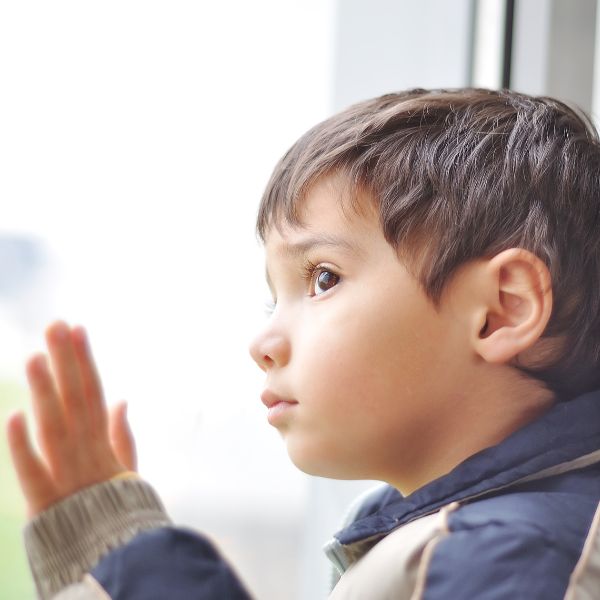
Author: Colleen Kraft, MD
For some children, the change in season brings with it a shift in mood. Is it a passing phase, or something more serious? Here’s what you need to know about depression, Seasonal Affective Disorder, and your child.
Seasonal Affective Disorder (SAD) — often referred to as “winter depression” — is a subtype of depression that follows a seasonal pattern. The most common form of SAD occurs in winter, although some people do experience symptoms during spring and summer.
While SAD is almost always talked about in terms of adults, children and adolescents are not necessarily immune. “SAD might exist among children, but it has not been well studied,” says Eve Spratt, M.D., MSCR, associate professor of pediatrics and psychiatry at the Medical University of South Carolina.
SAD usually develops in a person’s early 20s, and the risk for the disorder decreases as you get older. SAD is diagnosed most often in young women, but men who have SAD may suffer more severe symptoms. As winter approaches, 10 to 20 percent of us begin to suffer mild symptoms of SAD. We are saddened by the shortening days, climb into bed earlier and refuse to wake up when the morning light grows dim. For 14 million Americans, these symptoms grow considerably worse as winter progresses.
People with SAD may become fatigued and irritable. Eventually, they are no longer able to maintain their regular lifestyle. They may withdraw socially and no longer enjoy things that used to be fun. It’s as if a person’s batteries have just run down. For parents, SAD can obviously have a sharp impact on the ability to be an effective parent.
Children and adolescents can also suffer these symptoms. They may experience feelings of low self-worth and hopelessness. Children with depression struggle to concentrate on their schoolwork. Their grades may drop, worsening feelings of low self-esteem. Symptoms that last more than two weeks are cause for concern.
Researchers have not pinpointed what causes SAD. There is some evidence pointing to a disruption of a person’s “circadian rhythm” — the body’s natural cycle of sleeping and waking. As the days shorten, the decreasing amount of light can throw off the body’s natural clock, triggering depression. Sunlight also plays a role in the brain’s production of melatonin and serotonin. During winter, your body produces more melatonin (which encourages sleep) and less serotonin (which fights depression). Researchers do not know why some people are more susceptible to SAD than others.
In order to diagnose SAD, doctors need to perform a medical exam to rule out other possible causes of the symptoms, such as hypothyroidism, hypoglycemia, or mononucleosis. Doctors can administer questionnaires to determine mood and also to look for a seasonal pattern. “It’s difficult to diagnose children with depression in the first place, because it often presents as irritability, and they have a hard time understanding terms like ‘sad mood’ or ‘feeling blue,’” says Dr. Spratt. She points out that one of the most telling markers of depression in children is anhedonia — which means “absence of pleasure.” “So a good screening question to ask children is, ‘When was the last time you had a really good time?’”
Several effective treatments can help sufferers of SAD. Simply bringing more sunlight into your life can treat mild cases. Spend time outdoors everyday, even on cloudy days. Open window shades in your home. Exercise regularly and eat a healthy diet, one low in simple carbohydrates and high in vegetables, fruit, and whole grains. If you or your child do not improve, seeing your doctor and participating in treatment such as cognitive behavioral therapy may help.
The most common treatment for adults with SAD is light therapy. Patients sit for up to three hours in front of strong light boxes or wear light visors, with UV rays filtered out. However, light therapy is not recommended for children, says Dr. Spratt. If other treatments prove ineffective, prescription antidepressants may help regulate the balance of serotonin and other neurotransmitters that affect mood. Parents with children on antidepressants need to be vigilant in watching for agitation, anxiety, or insomnia and make sure they continue to see their physician on a regular basis.
Parents of children with depression should participate in their child’s treatment and recovery. Learn about the disorder and share what you learn with your child. Make sure your child completes his treatment everyday, no matter what form your doctor prescribes.
Plan low-key quality time together. Your child might not have the energy to go out, but reading a book or playing a family board game can be fun. Encourage your child to get exercise and spend time outdoors. Plan daily walks together. Fix healthy meals for your family, and establish a set bedtime to ensure he gets enough sleep and the same amount of sleep every night.

Whether noticing symptoms of SAD in yourself or depression in your child, take it seriously. Treating this disorder early and diligently can turn the dark days of winter into a pleasant time of togetherness for your family.
Source: www.healthychildren.org
The information provided is for general interest only and should not be misconstrued as a diagnosis, prognosis, or treatment recommendation. This information does not in any way constitute the practice of medicine, or any other health care profession. Readers are directed to consult their health care provider regarding their specific health situation. Marque Medical is not liable for any action taken by a reader based upon this information.


